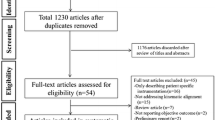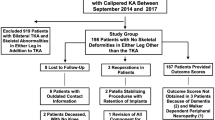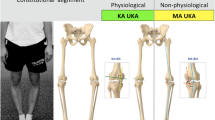Abstract
Purpose
Performing kinematically aligned total knee arthroplasty (TKA) with generic instruments is less costly than patient-specific instrumentation; however, the alignment and function with this new technique are unknown.
Methods
One hundred and one consecutive patients (101 knees) treated with kinematically aligned TKA, implanted with use of generic instruments, were prospectively followed. The medial collateral ligament was not released. The lateral collateral ligament was released in the 17 % of patients with a fixed valgus deformity. Six measures of alignment were categorized from a scanogram of the extremity, an axial scan of the knee, and an intraoperative measurement. Both the Oxford Knee and WOMAC™ scores were assessed as function. High function was a mean Oxford Knee score >41.
Results
The frequency that patients were categorized as in-range was 93 % for the mechanical alignment of the limb (0° ± 3°), 94 % for the joint line (−3° ± 3°), 57 % for the anatomic axis of the knee (−2.5° ± −7.4° valgus), 4 % for the varus–valgus rotation of the tibial component (≤0° valgus), 98 % for the rotation of the tibial component with respect to the femoral component (0° ± 10°), and 94 % for the intraoperative change in the anterior–posterior distance of the tibia with respect to the femur at 90° of flexion (0 ± 2 mm). The mean OKS score was 42, and WOMAC™ score was 89. For each alignment, the function was the same for patients categorized as an outlier or in-range.
Conclusions
The authors prefer the use of generic instruments to perform kinematically aligned TKA in place of mechanically aligned TKA because five of six alignments were accurate and because high function was restored regardless of whether patients had an alignment categorized as an outlier or in-range.
Level of evidence
IV.





Similar content being viewed by others
References
Baker PN, van der Meulen JH, Lewsey J, Gregg PJ (2007) The role of pain and function in determining patient satisfaction after total knee replacement. Data from the National Joint Registry for England and Wales. J Bone Joint Surg Br 89(7):893–900
Bedard M, Vince KG, Redfern J, Collen SR (2011) Internal rotation of the tibial component is frequent in stiff total knee arthroplasty. Clin Orthop Relat Res 469(8):2346–2355
Bellemans J, Colyn W, Vandenneucker H, Victor J (2011) The Chitranjan Ranawat Award: is neutral mechanical alignment normal for all patients? The concept of constitutional varus. Clin Orthop Relat Res 470(1):45–53
Bonner TJ, Eardley WGP, Patterson P, Gregg PJ (2011) The effect of post-operative mechanical axis alignment on the survival of primary total knee replacements after a follow-up of 15 years. J Bone Joint Surg Br 93-B(9):1217–1222
Bourne RB, Chesworth BM, Davis AM, Mahomed NN, Charron KD (2010) Patient satisfaction after total knee arthroplasty: who is satisfied and who is not? Clin Orthop Relat Res 468(1):57–63
Christen B, Heesterbeek P, Wymenga A, Wehrli U (2007) Posterior cruciate ligament balancing in total knee replacement: the quantitative relationship between tightness of the flexion gap and tibial translation. J Bone Joint Surg Br 89(8):1046–1050
de Jong RJ, Heesterbeek PJ, Wymenga AB (2010) A new measurement technique for the tibiofemoral contact point in normal knees and knees with TKR. Knee Surg Sports Traumatol Arthrosc 18(3):388–393
Dossett H, Swartz G, Estrada N, Lefevre G, Kwasman B (2012) Kinematically versus mechanically aligned total knee arthroplasty. Orthopedics 35(2):160–169
Eckhoff DG, Bach JM, Spitzer VM, Reinig KD, Bagur MM, Baldini TH, Flannery NM (2005) Three-dimensional mechanics, kinematics, and morphology of the knee viewed in virtual reality. J Bone Joint Surg Am 87(Suppl 2):71–80
Gu Y, Roth J, Howell SM, Hull ML (in press) How frequently do four methods for mechanically-aligning a total knee arthroplasty cause collateral ligament imbalance and change alignment from normal in Caucasians? J Bone Joint Surg Am
Hollister AM, Jatana S, Singh AK, Sullivan WW, Lupichuk AG (1993) The axes of rotation of the knee. Clin Orthop Relat Res 290:259–268
Howell SM, Hull ML (2012) Kinematic alignment in TKA: definition, surgical technique, and challenging cases orthopedic knowledge online 10(7).www.orthoportal.aaos.org/oko/article.aspx?article=OKO_ADU050#abstract
Howell SM, Rogers SL (2009) Method for quantifying patient expectations and early recovery after total knee arthroplasty. Orthopedics 32(12):884–890
Howell SM, Howell SJ, Hull ML (2010) Assessment of the radii of the medial and lateral femoral condyles in varus and valgus knees with osteoarthritis. J Bone Joint Surg Am 92(1):98–104
Howell SM, Kuznik K, Hull ML, Siston RA (2010) Longitudinal shapes of the tibia and femur are unrelated and variable. Clin Orthop Relat Res 468(4):1142–1148
Howell SM, Hodapp EE, Vernace JV, Hull ML, Meade TD (2012) Are undesirable contact kinematics minimized after kinematically aligned total knee arthroplasty? An intersurgeon analysis of consecutive patients. Knee Surg Sports Traumatol Arthrosc. doi:10.1007/s00167-012-2220-2
Howell SM, Howell SJ, Kuznik KT, Cohen J, Hull ML (2013) Does a kinematically aligned total knee arthroplasty restore function without failure regardless of alignment category? Clin Orthop Relat Res 471(3):1000–1007
Iranpour F, Merican AM, Dandachli W, Amis AA, Cobb JP (2010) The geometry of the trochlear groove. Clin Orthop Relat Res 468(3):782–788
Kamat YD, Aurakzai KM, Adhikari AR, Matthews D, Kalairajah Y, Field RE (2009) Does computer navigation in total knee arthroplasty improve patient outcome at midterm follow-up? Int Orthop 33(6):1567–1570
Kapandji IA (1987) The physiology of the joints, vol 2. Churchill Livingston, Edinburgh, pp 66–74
Klatt BA, Goyal N, Austin MS, Hozack WJ (2008) Custom-fit total knee arthroplasty (OtisKnee) results in malalignment. J Arthroplasty 23(1):26–29
Labek G, Neumann D, Agreiter M, Schuh R, Böhler N (2011) Impact of implant developers on published outcome and reproducibility of cohort-based clinical studies in arthroplasty. J Bone Joint Surg Am 93(Supplement 3):55–61
Lutzner J, Krummenauer F, Gunther KP, Kirschner S (2010) Rotational alignment of the tibial component in total knee arthroplasty is better at the medial third of tibial tuberosity than at the medial border. BMC Musculoskelet Disord 11:1–7. doi:10.1186/1471-2474-11-57
Lützner J, Kirschner S, Günther K-P, Harman M (2012) Patients with no functional improvement after total knee arthroplasty show different kinematics. Int Orthop 1–7. doi:10.1007/s00264-012-1584-8
Malkani AL, Rand JA, Bryan RS, Wallrichs SL (1995) Total knee arthroplasty with the kinematic condylar prosthesis. A 10-year follow-up study. J Bone Joint Surg Am 77(3):423–431
Matziolis G, Adam J, Perka C (2010) Varus malalignment has no influence on clinical outcome in midterm follow-up after total knee replacement. Arch Orthop Trauma Surg 130(12):1487–1491
Nedopil AJ, Howell SM, Rudert M, Roth J, Hull ML (In Press) How frequent is rotational mismatch within 0° ± 10° in kinematically-aligned TKA? orthopedics
Nunley R, Ellison B, Zhu J, Ruh E, Howell S, Barrack R (2012) Do patient-specific guides improve coronal alignment in total knee arthroplasty? Clin Orthop Relat Res 470(3):895–902
Pagnano MW, Hanssen AD, Lewallen DG, Stuart MJ (1998) Flexion instability after primary posterior cruciate retaining total knee arthroplasty. Clin Orthop Relat Res 356:39–46
Parratte S, Pagnano MW, Trousdale RT, Berry DJ (2010) Effect of postoperative mechanical axis alignment on the 15-year survival of modern, cemented total knee replacements. J Bone Joint Surg Am 92(12):2143–2149
Ritter MA, Davis KE, Meding JB, Pierson JL, Berend ME, Malinzak RA (2011) The effect of alignment and BMI on failure of total knee replacement. J Bone Joint Surg Am 93-A(17):1588–1596
Ritter MA, Davis KE, Davis P, Farris A, Malinzak RA, Berend ME, Meding JB (2013) Preoperative malalignment increases risk of failure after total knee arthroplasty. J Bone Joint Surg Am 95(2):126–131
The New Zealand Joint Registry 10 Year Report: January 1999 to December 2008 (2009), http://www.nzoa.org.nz/nz-joint-registry
Vanlommel L, Vanlommel J, Claes S, Bellemans J (2013) Slight undercorrection following total knee arthroplasty results in superior clinical outcomes in varus knees. Knee Surg Sports Traumatol Arthrosc. doi:10.1007/s00167-013-2481-4
Victor J, Banks S, Bellemans J (2005) Kinematics of posterior cruciate ligament-retaining and -substituting total knee arthroplasty: a prospective randomised outcome study. J Bone Joint Surg Br 87(5):646–655
Acknowledgments
We thank the imaging department and technicians at Methodist Hospital, Sacramento, CA for performing the scanograms and axial CT scans.
Author information
Authors and Affiliations
Corresponding author
Additional information
This work was performed at Methodist Hospital in Sacramento, CA, USA, and at the Department of Mechanical Engineering at the University of California at Davis, Davis, CA, USA.
Rights and permissions
About this article
Cite this article
Howell, S.M., Papadopoulos, S., Kuznik, K.T. et al. Accurate alignment and high function after kinematically aligned TKA performed with generic instruments. Knee Surg Sports Traumatol Arthrosc 21, 2271–2280 (2013). https://doi.org/10.1007/s00167-013-2621-x
Received:
Accepted:
Published:
Issue Date:
DOI: https://doi.org/10.1007/s00167-013-2621-x




